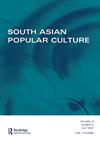Acculturation, cultural resistance, or cultural rigging: A study of folk performances in popular films
IF 0.3
0 ASIAN STUDIES
引用次数: 1
Abstract
ABSTRACT While, popular culture like films has more generalized mass appeal and flexibility of evolution with spatiotemporal changing dimensions of reality; folk cultures are mainly indigenous, relatively inflexible and slowly resistant to change. Popular films like Agantuk (1991) by Satyajit Ray, Barfi! (2012) by Anurag Basu and Jagga Jasoos (2017) by Anurag Basu make citations of three different tribal folk performances of Eastern India namely ‘Santhali’ of Jharkhand and West Bengal, ‘Purulia Chhau’ of West Bengal and ‘Bihu’ of Assam respectively. The very enactment of folk performances in the films attain the forms of ‘cultural guerrillas’ when the heteroglossia of indigenous marginal and minor folk culture make its existence in the majoritarian popular cultures like films and a cultural negotiation happens between two diagonally opposite cultures. ‘Cultural Rigging’ is a term coined by the Bengali Dalit poet Manohar Mouli Biswas to mention the tendency of a culture being performed by another culture when it becomes ‘highly enjoyable’ (38). The article aims to analyze the very tryst of the popular and folk culture through three intertwining concepts: acculturation, cultural resistance and cultural rigging with a select study of the films and tribal folk performances.文化适应、文化抵抗或文化操纵:流行电影中的民间表演研究
电影等流行文化具有更为普遍的大众吸引力和随着现实时空维度变化而进化的灵活性;民间文化主要是土著文化,相对不灵活,对变化的抵抗力很慢。受欢迎的电影,如萨蒂亚吉特·雷(1991),巴菲!(2012)和Jagga Jasoos(2017)分别引用了印度东部三种不同的部落民间表演,即贾坎德邦和西孟加拉邦的“Santhali”、西孟加拉邦和阿萨姆邦的“Purulia Chhau”。当土著边缘和次要民间文化的异质性在电影等多数流行文化中存在时,电影中的民间表演就达到了“文化游击队”的形式,两种对角文化之间发生了文化谈判“文化操纵”是孟加拉达利特诗人Manohar Mouli Biswas创造的一个术语,指的是当一种文化变得“高度愉快”时,它会被另一种文化所表演(38)。本文旨在通过对电影和部落民间表演的精选研究,从文化适应、文化抵抗和文化操纵三个相互交织的概念来分析流行文化与民间文化的幽会。
本文章由计算机程序翻译,如有差异,请以英文原文为准。
求助全文
约1分钟内获得全文
求助全文
来源期刊

South Asian Popular Culture
Arts and Humanities-Visual Arts and Performing Arts
CiteScore
1.00
自引率
0.00%
发文量
29
 求助内容:
求助内容: 应助结果提醒方式:
应助结果提醒方式:


